On Jeopardy the other night, the final question was:
"How many steps does the guard take during his walk across the tomb of the Unknown Soldier"
This is really an awesome sight to watch if you've never had the chance
. Very fascinating.
Tomb of the Unknown Soldier

1. How many steps does the guard take during his walk across the tomb of the Unknowns and why?
21 steps: It alludes to the twenty-one gun salute which is the highest honor given any military or foreign dignitary.
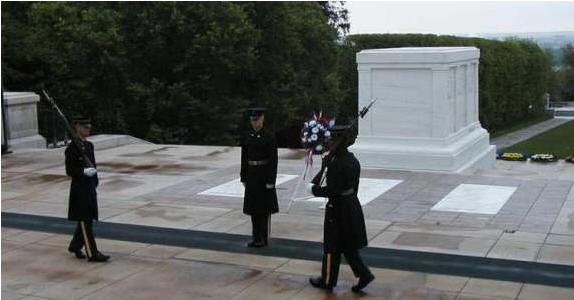
2. What is the step sequence?
The sentinel marches 21 steps across the black mat, past the final resting places of the Unknown Soldiers of World War I, World War II, Korea, and the crypt of the Unknown Soldier of
the Vietnam War. With a crisp turn, the sentinel turns 90 degrees (not about-face) to face east for 21 seconds. The sentinel then turns a sharp 90 degrees again to face north for 21
seconds. A crisp "shoulder-arms" movement places the rifle on the shoulder nearest the visitors to signify that the sentinel stands between the tomb and any threat. After the moment,
the sentinel paces 21 steps north, turns and repeats the process.
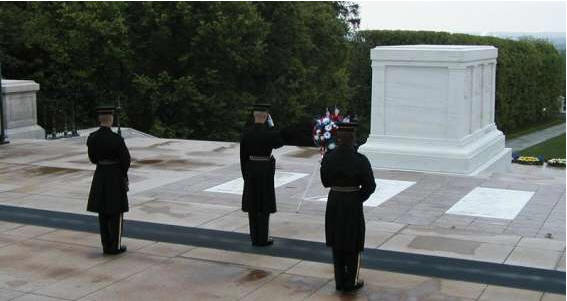
3. Why are his gloves wet?
His gloves are moistened to prevent his losing his grip on the rifle.
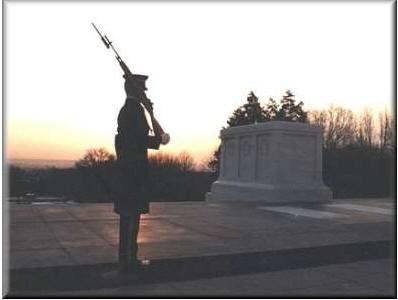
4. Does he carry his rifle on the same shoulder all the time and if not, why not?
He carries the rifle on the shoulder away from the tomb. After his march across the path, he executes an about face and moves the rifle to the outside shoulder.
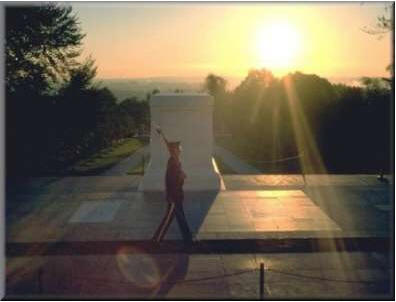
5. How often are the guards changed?
From 1926 through 1937, the Tomb was guarded only during daylight hours. Ever since 1937, the Tomb has been continuously guarded 24 hours a day, every day of the year. Tomb guards are
changed every thirty minutes between 8 AM and 7 PM during the period from early Spring to early Autumn (April 1 through September 30), and every hour between 8 AM to 5 PM the rest of
the year. At all other times (i.e., while the cemetery is closed), the guard is changed every two hours.
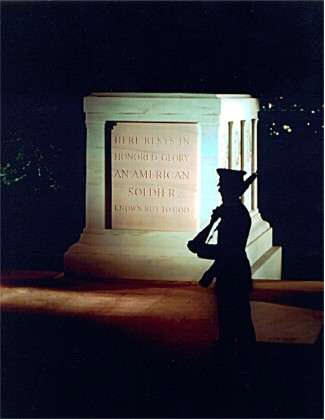
6. What are the physical traits of the guard limited to?
"Each soldier must be in superb physical condition, possess an unblemished military record and be between 5 feet, 10 inches and 6 feet, 4 inches tall, with a proportionate weight and
build."
Tomb Guard Identification Badge, first awarded in 1957, is a honor for which a guard qualifies by "flawlessly performing his duty for several months" and
passing a test.
Once the sentinel has completed his or her training,
he or she is examined formally for proficiency in performing the duties and in knowledge of ANC. He or she must first pass a written examination of 100 questions about ANC and then be
evaluated on proficiency in keeping watch at the Tomb of the Unknowns.
The Tomb Guard Identification Badge is one of the least awarded badges in the Army, second only to the Astronaut Badge. Since the sentinels are held to such a high standard, if they
ever do anything that is deemed behavior unbecoming a Tomb Guard or brings dishonor upon the Tomb, their badges may be revoked, even after [the sentinels] have left active duty
military service
There are no wrinkles, folds or lint on the uniform. Guards dress for duty in front of a full-length mirror.
The shoes are standard issue military dress shoes. They are built up so the sole and heel are equal in height. This allows the Sentinel to stand so that his back is straight and
perpendicular to the ground. A side effect of this is that the Sentinel can "roll" on the outside of the build up as he walks down the mat. This allows him to move in a fluid fashion.
If he does this correctly, his hat and bayonet will appear to not "bob" up and down with each step. It gives him a more formal and smooth look to his walk, rather than a "marching"
appearance. The soles have a steel tip on the toe and a "horseshoe" steel plate on the heel. This prevents wear on the sole and allows the Sentinel to move smoothly during his
movements when he turns to face the Tomb and then back down the mat.
Since any soldier wishing to become a sentinel must undergo rigorous training, including several hours a day of marching, rifle drill and uniform preparation,
and every tomb sentinel is expected to be completely versed in the history of both the tomb and of Arlington National Cemetery (including knowing how to find the graves of all the
prominent person buried in the cemetery), they don't necessarily have a lot of free time to devote to recreational activities.
Much time is spent studying the 175 notable people laid to rest in Arlington
National Cemetery.
Among the notables are:
President Taft,
Joe Lewis {the boxer}
Medal of Honor winner Audie L. Murphy, the most decorated soldier of WWII and of Hollywood fame.
Joe Louis (aka "The Brown Bomber"), Heavyweight Champion of the World between 1937 and
1949, is the boxer interred at Arlington National Cemetery. Joe E. Lewis, the comedian, is buried in New Jersey.) Although Joe Louis served in the Army during World War II he did not
meet the technical requirements for burial at Arlington, but he is interred there because President Reagan waived the requirements when Louis died in 1981.
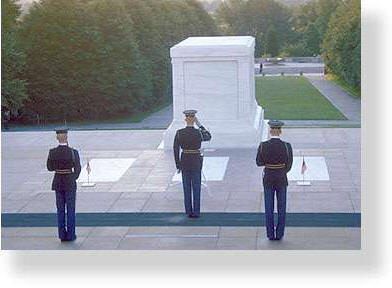
ETERNAL REST GRANT THEM O LORD AND LET PERPETUAL LIGHT SHINE UPON THEM.
In 2003 as Hurricane Isabelle was approaching Washington, DC, our US Senate/House took 2 days off with anticipation of the storm. On the ABC evening
news, it was reported that because of the dangers from the hurricane, the military members assigned the duty of guarding the Tomb of the Unknown Soldier were
given permission to suspend the assignment.. They respectfully declined the offer, "No way, Sir!" Soaked to the skin, marching in the pelting rain of a tropical storm, they said that
guarding the Tomb was not just an assignment, it was the highest honor that can be afforded to a serviceperson. The tomb has been patrolled continuously,
24/7, since 1930.
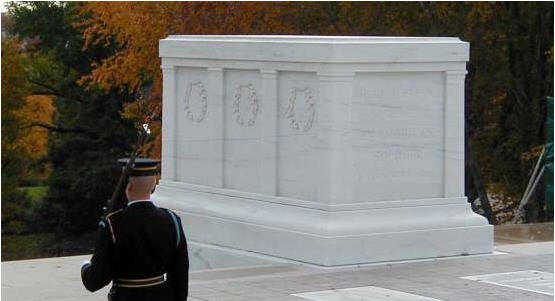
God Bless and keep them.
IN GOD WE TRUST
Please also see: https://www.tombguard.org/
http://www.snopes.com/military/unknown.asp
|
|